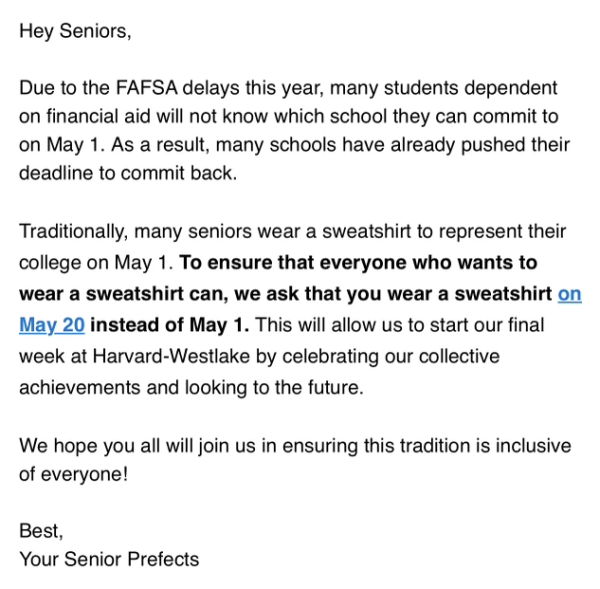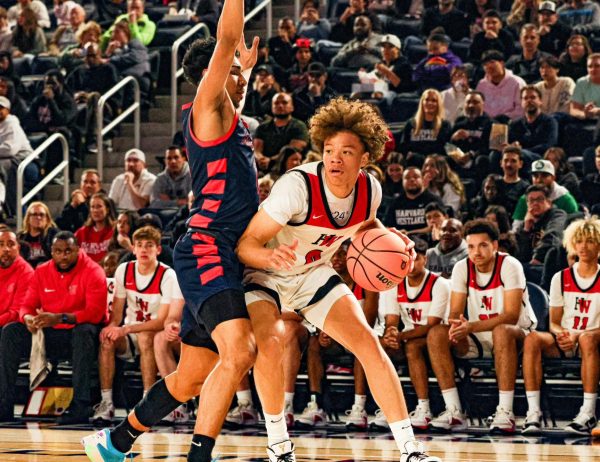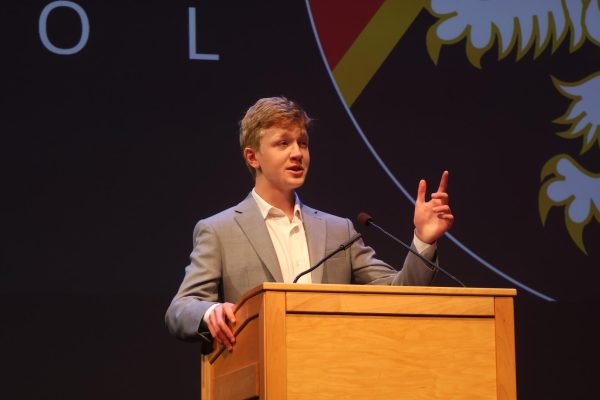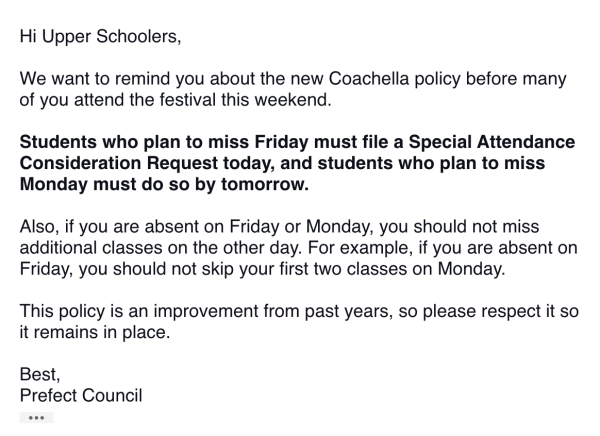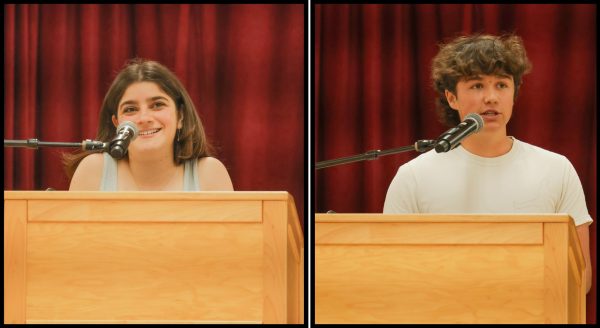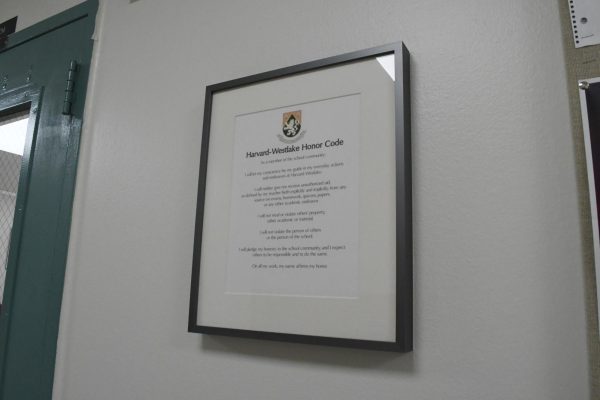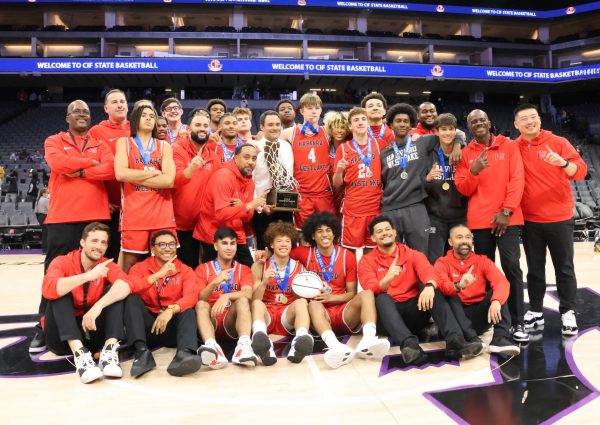Administration announces COVID-19 safety measures for the return from winter break
Student actively watches zoom classes
December 24, 2021
This page will be updated as new information about the school’s response to the Omicron COVID-19 variant is available.
Last updated Jan. 6, 2:23 p.m.
School mandates booster vaccination, updates close contact protocol after 170 students and employees test positive
President Rick Commons sent an all-school email confirming a return to in-person education and updating the school’s COVID-19 policies Jan. 5. The email announced that approximately 8% of 2,100 students and employees tested positive for COVID-19 at the school’s mandatory Jan. 3 testing day.
Commons said the 170 people who tested positive are distributed almost equally across the upper school and middle school campuses, and almost half of the positive tests confirmed diagnoses for students and teachers who were already aware that they contracted COVID-19 over winter break.
The email also announced that the school will require all students and employees to submit proof they received a COVID-19 booster vaccine by Feb. 1. If they are unable to do so, they will follow existing school protocols for unvaccinated students and employees by taking extra COVID-19 tests and completing daily health screenings. The Community Health Office (CHO) said in an email that the school will run booster vaccine clinics at the Middle School on Jan. 11-13 from 10 a.m. to 4 p.m. Parents must schedule students’ appointments, and if an appointment conflicts with a middle school student’s class period, the student will be excused from attending the class.
Head of Upper School Beth Slattery said the Feb. 1 deadline for booster vaccination was selected to provide enough time for students and employees to make appointments and update the school’s system. She said other health policies and currently high booster vaccination rates at the school will likely maintain campus safety.
“We believe a large portion of our community is boosted already, but our stricter masking policies and regular PCR testing over the next few weeks will hopefully minimize infection as much as we can,” Slattery said.
According to Commons’ email, the school will also return to its previous mask policy. In accordance with the Los Angeles Department of Public Health (LADPH) protocol, N95, KN95 or KF94 masks will be required in indoor spaces and must be worn in outdoor spaces when social distancing is not possible.
A PDF attached to Commons’ email outlined the school’s updated protocol for students and employees who either test positive with COVID-19 or come into close contact with someone who has.
“A close contact occurs when you have spent 15 minutes or more over any 24-hour period within six feet of anyone who subsequently, within 48 hours of your contact with them, tests positive for [COVID-19] or develops symptoms,” the guidelines said.
LADPH and school close contact guidelines are different for those who have received a COVID-19 booster and those who have not. Anyone who received a booster vaccine or their primary series of Pfizer or Moderna vaccinations within the past 6 months and anyone who received their primary Johnson&Johnson vaccine within the past two months may come to campus, but they must take two antigen tests: one as soon as they have been notified of their recent contact and a second test five days after their exposure. Close contacts are required to send their COVID-19 test results to the CHO and wear a mask at all times for ten days.
Those who come into close contact with someone diagnosed with COVID-19 but do not meet the booster or primary vaccine recency conditions must follow an adjusted set of rules. They are required to quarantine at home for five days and then submit a negative antigen test to the CHO before they can return to campus. They will also need to wear a mask at all times for the ten days subsequent to their exposure.
While the school updated its policies for those who were potentially exposed to COVID-19, Slattery said the administration does not plan to re-introduce the contact tracing app used by the school in early 2021.
“Our contact tracing will be conducted by speaking with the infected person and establishing their close contacts,” Slattery said. “Right now, we don’t intend to go back to using the app. We plan to test regularly on campus for the foreseeable future, so that will catch everyone who may have attended a crowded event. We hope that people will make good choices because that allows us to keep the school open.”
In response to the COVID-19 case count update and potential student absences, Math Department Head Kent Nealis said teachers are prepared to accommodate students learning from home.
“It does vary by class, but all classes have protocols for absent students,” Nealis said. “These protocols were developed and put in place at the beginning of the school year in anticipation that we potentially would have students and teachers who were unable to come to school. These protocols include making classes available remotely via Zoom, designated in-class note-takers who will distribute these notes to absent students and prerecorded lesson videos. Instructors will also be making themselves available through Zoom office hours on an as-needed basis.”
Community Health Office updates families on COVID-19 protocols
The Community Health Office (CHO) provided an update regarding the January return to school in an email sent Dec. 30. The email outlined protocols for COVID-19 testing, information about upcoming online learning days and new health requirements for students.
The CHO said it would conduct testing using drive-thru stations at both campuses from 8 a.m. to 7 p.m. on Monday. Like in previous testing clinics, the CHO said it would work in partnership with MEND Urgent Care, a walk-in center in Sherman Oaks.
The email urged students and employees to get their tests at the campus where they normally work or attend school, unless families have children at both campuses or employees work across campuses. The CHO said if community members do not follow this guidance, it would further complicate the testing process and undermine the results.
“If students or employees test on the wrong campus it will slow down the line considerably and make the test process more burdensome and less accurate,” the email said.
Since in-person school will not resume until Jan. 6, the CHO said academic department heads and teachers will update students before Monday regarding how classes will proceed during online learning Tuesday and Wednesday. Some teachers have kept in touch with students over break as department plans have been finalized.
Konnie Duan ’23 said although she understands the need to wait for test results, she is disappointed to return to online classes even for a short time.
“I would obviously rather be at school, but I feel like [online learning] is a feasible option just because we want to minimize the amount of risk there is on campus,” Duan said. “I feel like doing this is the best way possible to mitigate that risk. However, it’s still a bit sad not to like to be able to see friends these two days.”
While the email said all students are expected to participate in testing on Monday and in pooled testing Jan. 6 and Jan. 7, symptomatic students are instructed to alert MEND clinicians and remain inside their cars. Stella Glazer ’23, who currently has COVID-19 and believes she contracted it at a basketball away game, said she is unsure how to navigate the school’s testing protocols.
“None of the emails from the school specified what to do if you know you have COVID; they only said what to do if you have symptoms,” Glazer said. “So I’m planning on calling the school to ask what I should do about testing on Monday. I’m just hydrating, taking vitamins, sleeping and doing my best to get better so I can return to school [as soon as possible].”
The CHO said when in-person school resumes Jan. 6, it will require students to wear KN95 or N95 masks rather than allow them to choose their own face coverings. This decision marks a return to last spring’s mask policy. Duan said while she finds these masks cause physical discomfort, wearing them is a small price to pay for added protection against COVID-19.
“I’m glad the school is so vigilant about all of this, with [added] COVID procedures,” Duan said. “However, [KN95] masks make me feel super uncomfortable. They make my head hurt because they hurt my ears, and they don’t fit properly. But if it reduces the risk, I’m obviously willing. I’m happy the school is taking these precautions.”
The CHO reiterated its plan to mandate the COVID-19 booster vaccine for eligible students and faculty in the near future. This would include almost the entire school community if the Food and Drug Administration (FDA) follows through with its plan to approve the Pfizer booster for ages 12-15 in the coming days. The CHO also announced another booster vaccine clinic for those 16 and older Jan. 7, while saying eligible students may want to receive their booster over winter break.
“If you have not already done so, please consider using the time off over the holidays or Jan. 3 to get a booster shot if you are eligible,” the CHO email said.
In a follow-up email to families Dec. 31, Head of Upper School Beth Slattery gave additional information regarding next week’s return. Slattery said the school will emphasize asynchronous learning rather than Zoom classes during the two remote days. She said the school expects some positive cases during testing, and teachers will work closely with quarantining students to keep them from falling behind.
Slattery said while she hopes to maintain in-person learning, there is no guarantee that it will continue as the Omicron variant sweeps the nation.
“The school is committed to staying in person, but I cannot promise that circumstances will always allow for that,” Slattery said in the email. “The only promise I can make is that we will make the best decisions we can, following guidelines and taking into account the mental and physical health of all the people in our care.”
President Rick Commons announces schedule for January return
President Rick Commons sent an all-school email announcing updated COVID-19 policies Dec. 23 for the return to school after winter break.
According to the email, students will not attend school Jan. 3, but will be required to participate in on-campus COVID-19 testing from 8 a.m. to 5 p.m. that day. While Campus will be closed Jan. 4 and Jan. 5, classes will be held online. In-person learning and campus activities will resume Jan. 6. Athletic teams that are in season and have tested athletes for COVID-19 throughout winter break will be able to participate in on-campus activities Jan. 3-5.
Commons wrote that students will receive more information about online academic instruction by Jan. 3 and will be able to collect class materials and other items from their lockers after completing their COVID-19 tests.
Commons recommended that school employees and students receive a booster vaccine over winter break, and he said the school will host additional booster clinics in early January. He said the school will follow vaccination guidelines from the Center for Disease Control and Prevention (CDC) and Food and Drug Administration (FDA).
“Recently, the CDC and FDA have recommended booster vaccine shots for everyone over the age of 16 who is eligible, and it is likely that the CDC and FDA will soon change the definition of ‘fully vaccinated’ to include a booster shot,” Commons wrote in the email. “The school expects to adopt this change as well.”
Head of Upper School Beth Slattery said the school currently recommends that students and faculty receive a booster vaccine and does not require it, but she said the school will likely enforce a booster vaccine mandate in the near future.
“This is not an official requirement yet, but we wanted to give people the chance to get their booster now since we expect to make it a requirement,” Slattery said. “This will likely happen when the CDC officially revises their definition of ‘fully vaccinated,’ but it may happen before that.”
Slattery said the school’s decision to move classes online until the community’s COVID-19 test results have been processed is part of an attempt to avoid a large outbreak that could lead to prolonged campus closure. She said that a longer duration of online instruction is improbable because of the precautions taken by the administration.
“I think it is highly unlikely that we will move to Zoom for an extended period,” Slattery said. “In this case, we simply wanted to be able to test everyone before returning to school, and since many people are traveling over the break, we knew we wouldn’t be able to test everyone until Monday. Right now, we do not have a plan for extended Zoom school because we do not expect that to happen.”
Nilufer Mistry-Sheasby ’24 said she will feel more comfortable on campus if more students take advantage of the school’s booster clinics.
“In light of Omicron’s increased vitality, I would definitely feel safer if everyone on campus who was eligible received the booster,” Mistry-Sheasby said. “Considering that it is provided by the school and that we are all required to be vaccinated anyway, I do not think encouraging students to get the booster would be that unreasonable.”
Mistry-Sheasby said she is not looking forward to attending school online after winter break considering her experiences with virtual learning last year.
“For me, Zoom school was boring, often challenging to keep up with and unpleasant because of a lack of extracurricular and social engagement,” Mistry-Sheasby said. “Even though I understand that this arrangement for right after the break is only temporary, the thought of returning to school on Zoom gives me an anxiety-inducing, almost PTSD-like feeling in the pit of my stomach.”
Visual Arts Teacher Alexandra Pacheco Garcia, who teaches photography, said moving school online is the best possible solution to the problem presented by the Omicron variant but said she is disappointed about losing in-person class time.
“I’m not excited to return to Zoom, but I don’t see another option, and I don’t think the solution is [of] canceling class for two days makes sense either,” Pacheco Garcia said. “We know how to do Zoom. We’ve done it for a year and a half, so we’ll do what we have to do. It’s disruptive to a class like mine—we’re in the darkroom now, and we don’t have access to our materials for our current project. That said, though, we know how to do Zoom, and I have some at-home activities that we’ll do during the next couple of days.”
Jack Moreland ’23 said he is glad the school will wait for COVID-19 test results before resuming campus activities although he said he prefers in-person school over online classes.
“I think the schedule that the school is using is appropriate given the new variant and the end of winter break,” Moreland said. “Many people probably traveled or at least interacted with more people than they usually do, so intuitively it seems like a good idea to establish another baseline like they did at the start of the year.”

































